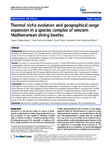Thermal niche evolution and geographical range expansion in a species complex of western Mediterranean diving beetles
| dc.contributor.author | Hidalgo-Galiana, A | |
| dc.contributor.author | Sánchez-Fernández, D | |
| dc.contributor.author | Bilton, David | |
| dc.contributor.author | Cieslak, A | |
| dc.contributor.author | Ribera, I | |
| dc.date.accessioned | 2016-11-29T10:19:15Z | |
| dc.date.available | 2016-11-29T10:19:15Z | |
| dc.date.issued | 2014-12 | |
| dc.identifier.issn | 1471-2148 | |
| dc.identifier.issn | 1471-2148 | |
| dc.identifier.other | 187 | |
| dc.identifier.uri | http://hdl.handle.net/10026.1/8042 | |
| dc.description.abstract |
BACKGROUND: Species thermal requirements are one of the principal determinants of their ecology and biogeography, although our understanding of the interplay between these factors is limited by the paucity of integrative empirical studies. Here we use empirically collected thermal tolerance data in combination with molecular phylogenetics/phylogeography and ecological niche modelling to study the evolution of a clade of three western Mediterranean diving beetles, the Agabus brunneus complex. RESULTS: The preferred mitochondrial DNA topology recovered A. ramblae (North Africa, east Iberia and Balearic islands) as paraphyletic, with A. brunneus (widespread in the southwestern Mediterranean) and A. rufulus (Corsica and Sardinia) nested within it, with an estimated origin between 0.60-0.25 Ma. All three species were, however, recovered as monophyletic using nuclear DNA markers. A Bayesian skyline plot suggested demographic expansion in the clade at the onset of the last glacial cycle. The species thermal tolerances differ significantly, with A. brunneus able to tolerate lower temperatures than the other taxa. The climatic niche of the three species also differs, with A. ramblae occupying more arid and seasonal areas, with a higher minimum temperature in the coldest month. The estimated potential distribution for both A. brunneus and A. ramblae was most restricted in the last interglacial, becoming increasingly wider through the last glacial and the Holocene. CONCLUSIONS: The A. brunneus complex diversified in the late Pleistocene, most likely in south Iberia after colonization from Morocco. Insular forms did not differentiate substantially in morphology or ecology, but A. brunneus evolved a wider tolerance to cold, which appeared to have facilitated its geographic expansion. Both A. brunneus and A. ramblae expanded their ranges during the last glacial, although they have not occupied areas beyond their LGM potential distribution except for isolated populations of A. brunneus in France and England. On the islands and possibly Tunisia secondary contact between A. brunneus and A. ramblae or A. rufulus has resulted in introgression. Our work highlights the complex dynamics of speciation and range expansions within southern areas during the last glacial cycle, and points to the often neglected role of North Africa as a source of European biodiversity. | |
| dc.format.extent | 0-0 | |
| dc.format.medium | Electronic | |
| dc.language | en | |
| dc.language.iso | en | |
| dc.publisher | Springer Science and Business Media LLC | |
| dc.subject | Thermal niche evolution | |
| dc.subject | Cold tolerance | |
| dc.subject | Demographic expansion | |
| dc.subject | Dytiscidae | |
| dc.subject | Western Mediterranean | |
| dc.title | Thermal niche evolution and geographical range expansion in a species complex of western Mediterranean diving beetles | |
| dc.type | journal-article | |
| dc.type | Journal Article | |
| dc.type | Research Support, Non-U.S. Gov't | |
| plymouth.author-url | https://www.webofscience.com/api/gateway?GWVersion=2&SrcApp=PARTNER_APP&SrcAuth=LinksAMR&KeyUT=WOS:000342589000001&DestLinkType=FullRecord&DestApp=ALL_WOS&UsrCustomerID=11bb513d99f797142bcfeffcc58ea008 | |
| plymouth.issue | 1 | |
| plymouth.volume | 14 | |
| plymouth.publication-status | Published | |
| plymouth.journal | BMC Evolutionary Biology | |
| dc.identifier.doi | 10.1186/s12862-014-0187-y | |
| plymouth.organisational-group | /Plymouth | |
| plymouth.organisational-group | /Plymouth/Faculty of Science and Engineering | |
| plymouth.organisational-group | /Plymouth/Faculty of Science and Engineering/School of Biological and Marine Sciences | |
| plymouth.organisational-group | /Plymouth/REF 2021 Researchers by UoA | |
| plymouth.organisational-group | /Plymouth/REF 2021 Researchers by UoA/UoA07 Earth Systems and Environmental Sciences | |
| plymouth.organisational-group | /Plymouth/Research Groups | |
| plymouth.organisational-group | /Plymouth/Research Groups/Marine Institute | |
| plymouth.organisational-group | /Plymouth/Users by role | |
| plymouth.organisational-group | /Plymouth/Users by role/Academics | |
| dc.publisher.place | England | |
| dcterms.dateAccepted | 2014-08-11 | |
| dc.identifier.eissn | 1471-2148 | |
| dc.rights.embargoperiod | Not known | |
| rioxxterms.versionofrecord | 10.1186/s12862-014-0187-y | |
| rioxxterms.licenseref.uri | http://www.rioxx.net/licenses/all-rights-reserved | |
| rioxxterms.licenseref.startdate | 2014-12 | |
| rioxxterms.type | Journal Article/Review |


